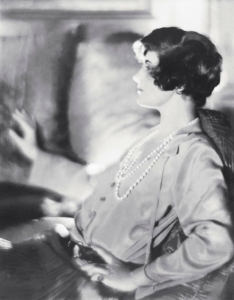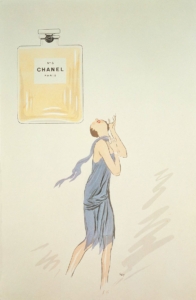
A circa-1920 portrait of Coco Chanel.
The world’s most famous fragrance is commemorating a century since its debut—here are the details you should know about this celebrated scent.
One hundred years after its launch, Chanel No. 5 arguably remains the world’s most popular fragrance, with beauty pundits suggesting that a product in this family – from the eau de parfum to the body lotion, the soap and more – is sold online and in stores every minute.
From artists to A-list actresses (and at least one famous actor), Chanel No. 5 has transcended fragrance to become an iconic element in popular culture. But how did a perfume make the leap from a visionary idea to the world’s most celebrated scent? Here are the top-five facts about the Chanel product that continues to cause a frenzy:

Chanel No. 5 Eau de Parfum, available at Chanel Fragrance & Beauty Boutique in Aventura Mall.
It all started in Monte Carlo. Coco Chanel was vacationing in the south of France with her acknowledged lover, the Grand Duke Dmitri Pavlovich; the cousin of Russia’s Tsar Nicholas II, Pavlovich also was acquainted with Moscow-born Ernest Beaux, the tsar’s former perfumer. It was the duke who introduced Beaux to Mademoiselle Chanel, who already had been mulling the idea of creating a fragrance—but something modern, she had decided, vs. the single-note scents so prevalent during the era.
Beaux’s creation was indeed a gamechanger. With notes that included May rose, jasmine, ylang-ylang and neroli—all harvested in Grasse, the town located in the hills north of Cannes—Beaux’s original formulation contained no fewer than 80 ingredients, with sandalwood and vanilla added for warmth. This modern take on perfume differed markedly from the heavy violet and rose scents that dominated fragrance trends in the early 20th century—and in 100 years, the Chanel No. 5 formulation has changed very little. That’s likewise true of its ingredients: May rose, for example, takes its name from the month in which its harvested, a three-week period that Chanel fragrance experts call “a mad race against time,” with all flowers gathered in the morning, before the sun is too high in the sky.

The jasmine field in Grasse, France. Chanel owns the fields used to farm many of its key flowers, and in recent years has updated its farming and production methods with sustainability in mind.

A bushel of May roses, harvested in the early-morning hours over three weeks in May each year.
The No. 5 name is rooted in both fact and superstition. Among the most-discussed elements of No. 5 lore is that it takes its name from being the fifth scent Beaux introduced to Coco Chanel. While that may be true, Chanel’s superstitious nature and love of astrology also played a role: The couturier was born on August 19, 1883, making her a Leo, the fifth sign of the zodiac (lions as decorative elements can still be found in her apartment atop Chanel’s Rue Cambon flagship in Paris). Never one to tempt fate, Chanel also chose an auspicious date for No. 5’s debut: May 5 (i.e., the fifth day of the fifth month) in 1921.
Don’t miss the secret in the bottle design. Not unlike the clothes she designed, Chanel favored modernity for No. 5’s bottle and oversaw a sleek and chicly simple look in clear crystal (by contrast, consider the ornate bottle created for Guerlain’s Shalimar, which debuted the same year). But if you look at a bottle of Chanel No. 5 from above, there was another detail known only to Coco Chanel at the time: Its shape, an elongated octagon, is meant to mimic the layout of Paris’s Place Vendôme. Rue Cambon is just one street over from Place Vendôme, and Chanel later lived at the Hotel Ritz, also located on the famed Paris square.
Chanel No. 5 continues to inspire artists and movie stars alike. In April 1952, Life magazine reported Marilyn Monroe’s response when asked by a reporter what she wore to bed: “I only wear Chanel No. 5.” In the years since, Andy Warhol interpreted the Chanel No. 5 bottle in a series of prints he released in the 1980s, while iconic women from Catherine Deneuve to Ali MacGraw, Audrey Tautou and, most recently, Marion Cotillard have appeared in No. 5 campaigns over the years. Nicole Kidman’s three-minute Chanel No. 5 ad (directed by Baz Luhrmann, who also worked with Kidman on 2001’s Moulin Rouge) in 2004, meanwhile, cost $33 million and continues to rank as the most expensive TV commercial ever produced. One actor also decided to lend his famous face to Chanel No. 5: Brad Pitt appeared in the scent’s campaign in 2012.

Georges Goursat, a French caricaturist who worked under the name Sem, created the earliest known advertisement for Chanel No. 5, featuring a flapper-style woman gazing up at the bottle.
Chanel No. 5 is available at Chanel Fragrance & Beauty Boutique. For more information, contact the store at 305-933-7155.